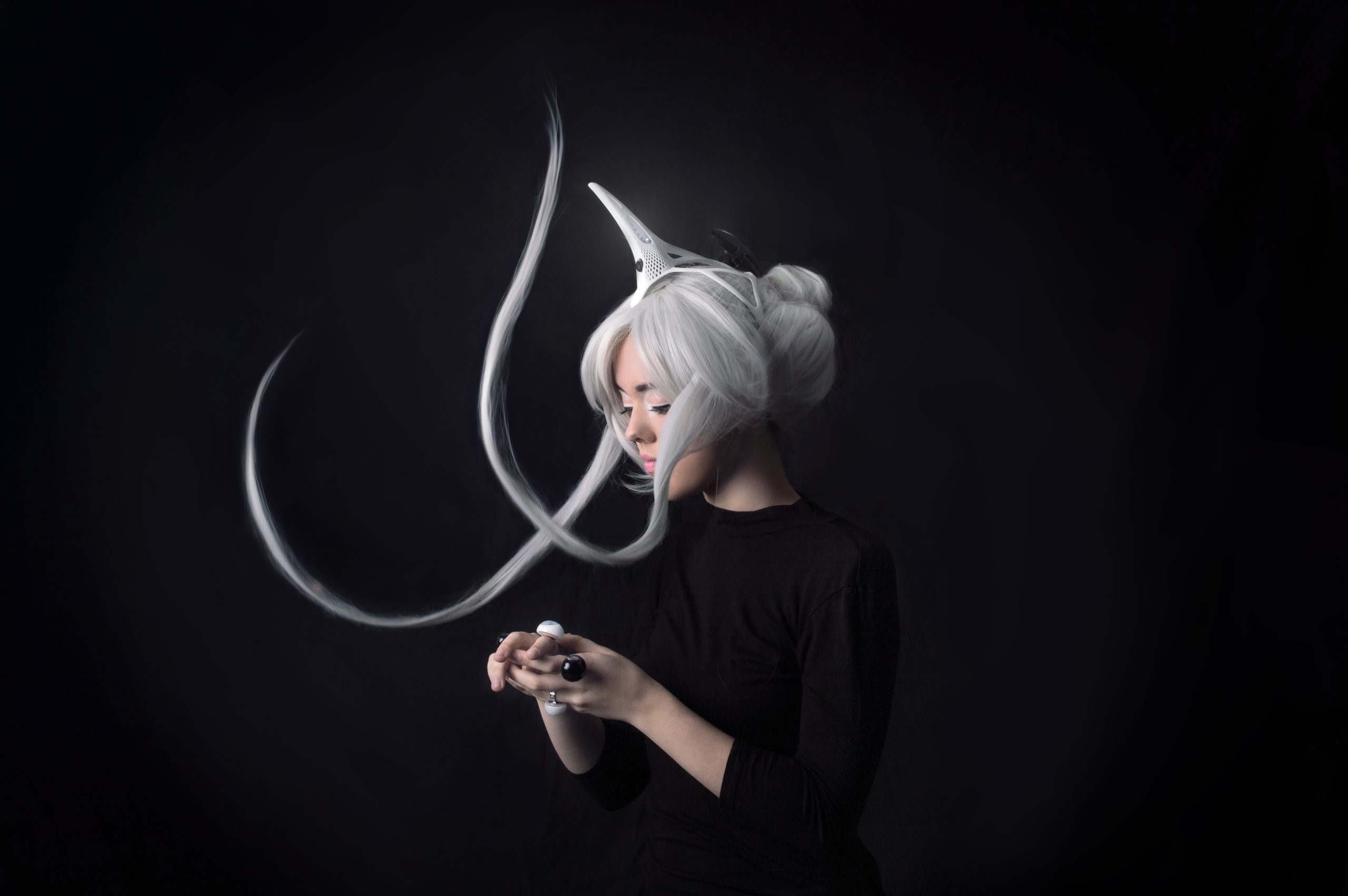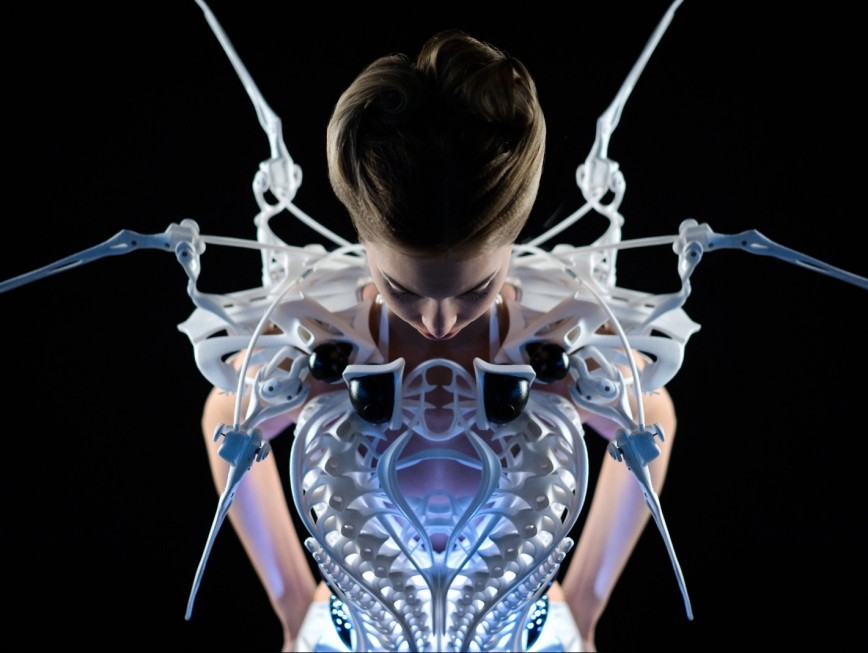Anouk Wipprecht is the first artist selected to spend a SPARKS Residency at the Ars Electronica Futurelab. The well-known Fashion-Tech Designer has worked the communication aspects of her apparel into an unicorn-shaped headset. During her stay at the Futurelab, she teamed up with a team of Neuroscientists and experts, creating an accessory that logs the wearer’s observations through EEG.
Picking up brain activity with a built-in camera that takes short movies when the wearer’s attention strikes. Her personal focus is on children but ‘she’d wear it herself too’ she said. During a pause in one of her many team meetings, Anouk Wipprecht talked to us about how the idea came about and how she’s developed it up to this point.

Behind the scenes of main image photoshoot. Credit: Courtesy of Anouk Wipprecht
Based on the media buzz about you, your name is synonymous with Fashion-Tech. What’s the interrelationship between your interest in fashion and the field of responsible research and innovation [RRI]?
Anouk Wipprecht: By curiosity , I try to connect myself to different fields. From wearables to robotics, from micro-controllers to sensors, to an ongoing research into reliably (and wirelessly) measuring bio-signals. I see fashion as a token of expression and communication and I like to make that electronic and interactive. My designs monitor your body signals, stress levels and measure out what happens in your surroundings. It processes data and data visualizes the outcome by means of expression, that happens within the garments, often of an computational nature. A part from that, my work is to create. Another to demonstrate. A third one to research the interactions that my designs cause and confluence and engineer the finding back to my system. These prototypes need to be ‘worn’ in order to be tested. I see them as case-studies as every design is measuring, triggering and also visualizing another interaction that I test out.
An example of an interactive dress: Robotic Spider Dress powered by Intel Edison. Credit: Courtesy of Anouk Wipprecht
As you already mentioned, your designs are often fully High-Tech embed: the design of your dresses as well as the system behaviors and the planned interactions look seamlessly connected. How did it come about that with your current Futurelab residency you are focused on creating a ‘device’ instead?
Anouk Wipprecht: This is correct. On the topic of ‘wellness’ I chose a different track. Creating a custom-designed ensemble was my original intent but the project manageress Claudia [SPARKS project liaison Claudia Schnugg] pointed me on the “device” direction, allowing to use my concepts to develop an instrumentation that addresses [mental] health through the concept of RRI via fashion. It got me to be creating a cool product that has the potential to yield significant benefits for therapies and research.

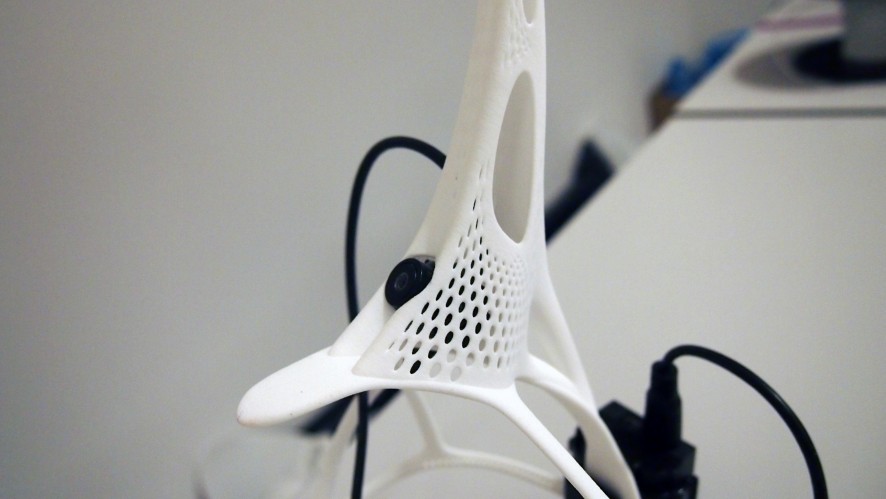
Prototypye camera horn with embedded FlyWire camera. Credit: Courtesy of Anouk Wipprecht
You work with EEG sensors that monitor the brain activity and when the wearer’s focus threshold hits 80% it triggers a movie capture to indicate the wearers attention point and logs it. What are you trying to find out?
Anouk Wipprecht: Based on my former Intel -Edison- based ‘Synapse’ -dress, a dress which logs your mood , we researched the wearer’s focus points. This time through a more adapted accessories than my former 3D printed bodice: I playfully try to sets an art-deco style headpiece in the shape of a unicorn horn, mounted on the head as an interface between the brainwaves and the surroundings. A state of high concentration abstracted through EEG allows the wearer to activate and trigger a video capture. Controlled, quantified and modulated by leveraging inputs from the body’s electrical system, once more through the Intel -Edison- module, I am trying to monitor people’s vision, what is in front of them. My aim is to create a learning system that brings more self-awareness to the wearer. To show people what engages them, not only that something triggers their attention but also what triggers that state. It makes the biofeedback method much more gratifying and comprehensible. With my remote team in Hawaii and Neuroscientists I test possibilities.
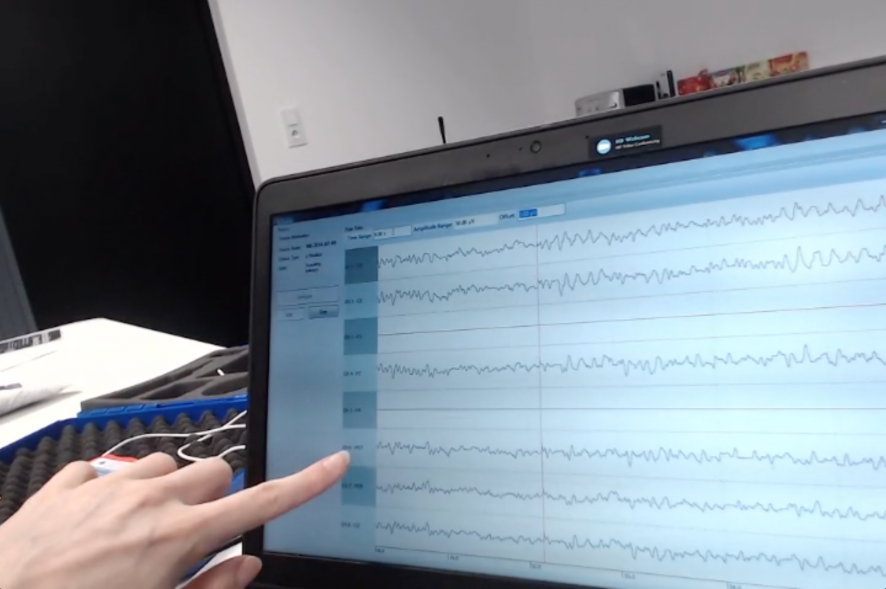

g.Sahara [dry electrode] based EEG measurements + Intel Edison development. Credit: Courtesy of Anouk Wipprecht
How does this set apart from the current state of wearables, utilizing an on-body camera?
Anouk Wipprecht: By the current state of wearables as activity trackers and body sensors, I get the information that there is something happening , for example – your heartbeat goes up, or your stress level rises. But it does nothing to help you understand yourself. By placing an extra- set of eyes on the body, I am able to create an interface which not only knows that you stare at something, but also why. Having a grip on what gets your attention throughout the day without having to record it yourself, makes you aware of certain habits you face.

Anouk Wipprecht with Dr. Christoph Hintermüller of G.Tec with g.Sahara electrodes, Courtesy of Anouk Wipprecht
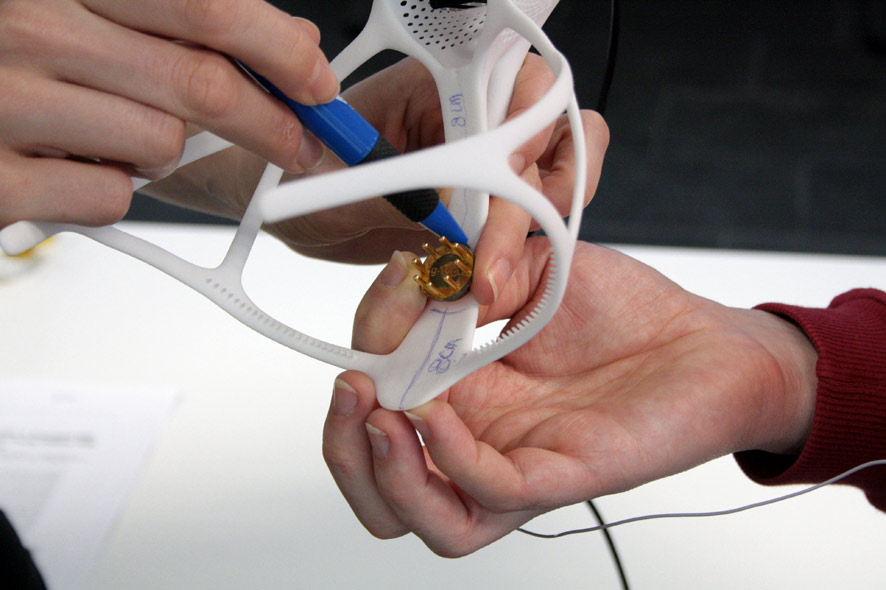
Credit: Anouk Wipprecht
You already started proprietary. How much have your designs changed since you’ve been working together with the Ars Electronica Futurelab crew?
Anouk Wipprecht: The cool thing about being here is that you get to deal with people who are highly specialized in a wide array of fields. Receive cohesive feedback and suggestions in response to specific queries, whether they’re about design or technology is really important in a process like this. I, for example, was playing around with the Intel Real Sense, and there were two other teams busy with that too. On the same floor! In a scientific sense, my residency association with the Ars Electronica Future lab provides me with access to channels like the company G.Tec, who I have a meeting with today, at which we’ll be talking about attention-deficit. They are market leaders in Medical EEG devices. But also, as a designer you often have limited access to high-level science departments. Ars Electronica is an institution that’s famous for transdisciplinary research, so without this linkup, I would not be in contact with Dominik Laister at the Barmherzige Brüder Hospital in Linz , who became a very valuable advisor. As a member of the staff of their autism competence -center, he was able to give me information about the potential effectiveness of the device, links to certain research papers, and helps me to integrate important features into the concept. For example P300 within the 10/20 system and Nc trigger points that I am interested in for attention-deficit.
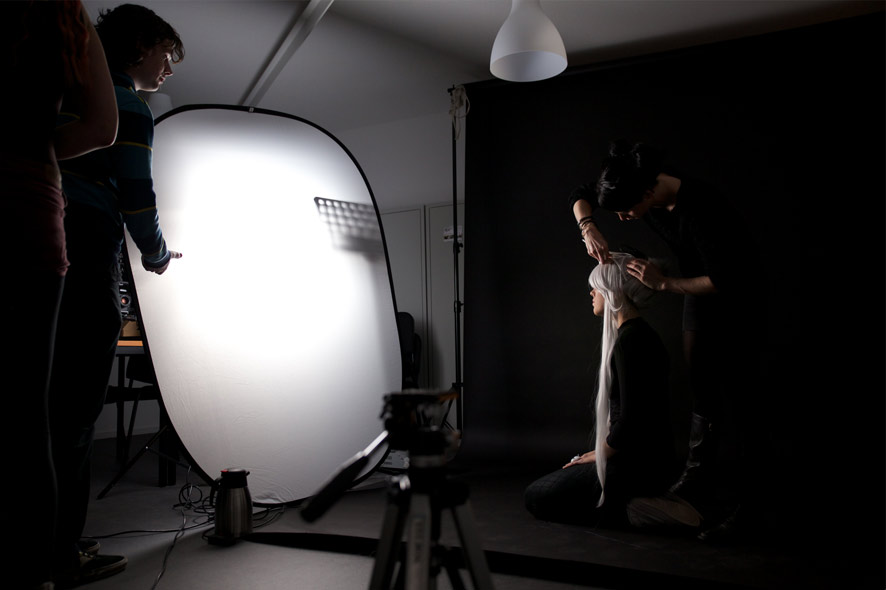
Photoshoot of main image Credit: Courtesy of Anouk Wipprecht
Are there any personal points of contact between you and the subject of ADHD?
Anouk Wipprecht: My designs are conceived to perform a certain function—they communicate. For example, they use smoke to say “Hey, don’t invade my personal space!” and are thus an extension of natural physical reactions. In a nutshell, what my fashion brings about, is non-verbal communication. Children on the ADHD spectrum are constantly beset with communication problems. Fashion sort of translates messages in spheres in which verbal exchange fails. The design can cater to overcome communication difficulties in a playful way. Tracking your mind without having to wear an invasive electrode cap, which is used in a therapeutic setting. It is set in a more game-like environment. My concrete approach as a designer is to get EEG devices out of its medical niche. For children, it’s primarily designed as an aid for use during therapy sessions , to facilitate conversing with the therapist. As street wear, it’s of course less helpful when the aim is to remain in conspicuous. Though I, as a geeky-conscious girl, would certainly wear it.

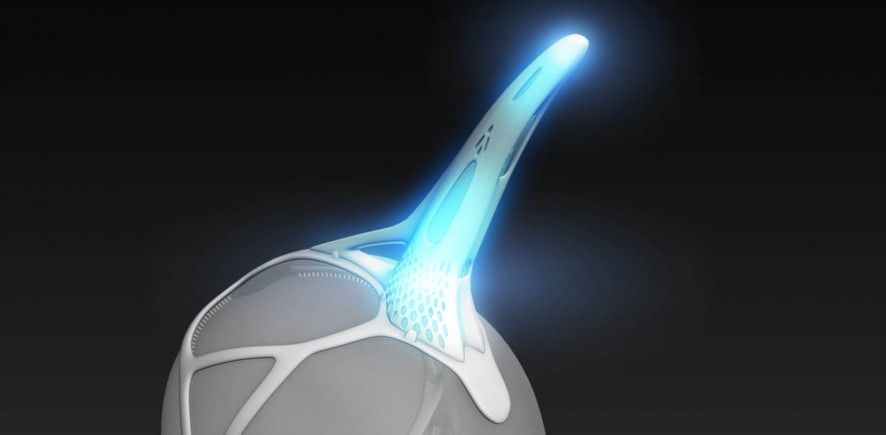
Series of Real Sense horn LED renders with L.A. based Igor Knezevic, Credit: Anouk Wipprecht and Igor Knezevic
Can you name an example what you have in mind that the device would be able to log?
Anouk Wipprecht: I hope that the device fosters a learning effect to enable the wearers to recognize which invasive events over the course of the day have had a strong effect on their brain activity. The horn’s built-in camera records the child’s experiences — for instance, during a visit to the zoo. Depending on which animal the child is seeing, there’s an emotional reaction and the brain waves’ swings trigger the camera. Now, things are pretty fuzzy in data , but by development , I hope to design this better.
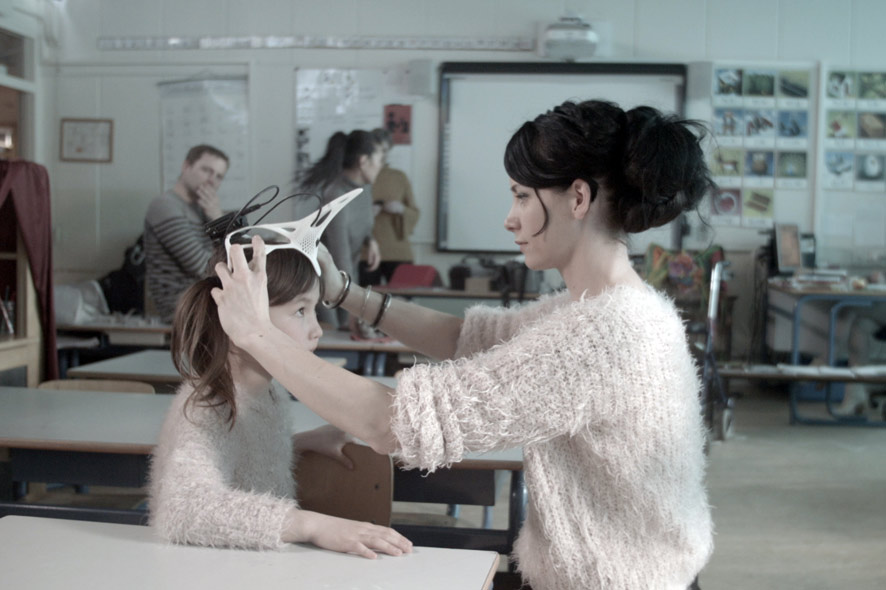

Behind the scenes during the teaser movie with Vita and Local Androids. Credit: Courtesy of Local Androids
Credit: Local Androids
Why is the development of this project so close to your heart?
Anouk Wipprecht: I focus on children, generally speaking, anyone can wear this to measure his/her brain activities and to draw conclusions from them — for example, how we react to various colors; how a piece of chocolate cake produces a spike; or even how we respond to hearing our own name. But the essential feature is that these brain activities can also be evaluated as to when and how the particular child becomes especially attentive, and this can suggest the point of departure of the respective therapeutic measures. Conceived as a playful element are the built-in LEDs that flash during brain activities. It can make the therapist’s job easier by enabling recognition of precisely these points. That can certainly be interesting for all wearers by potentially pointing out sources of irritation and stress that they would otherwise not be cognizant of. Wearing this unicorn horn-shaped agent is a way for children to escape being socially stigmatized. It demonstrates in a playful way that by giving current medical devices a fashionable twist, you can create something which is easier to digest from an UX state of mind.

Behind the scenes during the teaser movie with Vita and Local Androids. Credit: Courtesy of Local Androids
The designer is using:
Intel Edison, https://www.adafruit.com/datasheets/EdisonDatasheet.pdf
FlyWire-Camera, http://www.flywirecameras.com/
EEG, http://www.gtec.at/ [g.Sahara system]
Tests with:
Intel RealSense Camera R200 http://click.intel.com/intel-realsense-developer-kit-r200.html
Anouk Wipprecht hopes to make the project Open Source available later this year.
This project is part of Sparks, a H2020 project funded by the European Commission
